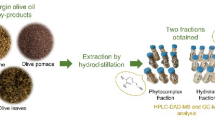Abstract
By definition, virgin olive oil is consumed unrefined, although a great proportion of the olive oil produced has to be refined to render it edible. Phenolic compounds are among the substances eliminated during the refining process; in the present work these were characterized by HPLC, and their evolution during the different refining steps was studied. The complete refining process removed most polyphenols from oils, but the behavior of individual compounds at each step also was observed. o-Diphenols (hydroxytyrosol, catechol, and hydroxytyrosol acetate) and flavonoids (luteolin and apigenin) were eliminated first during the alkaline treatment. Tyrosol and 4-ethylphenol remained in the oil until the deodorization step. A large amount of phenolic compounds was discovered in the refining by-products such as soapstocks and deodorization distillates. In the latter streams, the concentrations of tyrosol and 4-ethylphenol reached up to 149 and 3720 mg/kg by-product, respectively. This high level of 4-ethylphenol and its well-known strong off-odor can interfere during further processing of the deodorization distillates, and this must be taken into account when deciding what is to become of them. Similarly, the results of this work open the possibility of recovering phenolic compounds from the “second centrifugation olive oils” by adding a new washing step prior to the refining process. By including this new step, the most polar polyphenols, hydroxytyrosol and tyrosol, will diffuse from oil to water and a concentration of up to 1400 mg/L of hydroxytyrosol may be achieved.
Similar content being viewed by others
References
Ruiz-Méndez, M.V., and M.C. Dobarganes, Olive Oil and Olive Pomace Oil Refining, Oleagineux Corps Gras Lipides 6:56–60 (1999).
Alba, J., F. Hidalgo, M.A. Ruiz, F. Martínez, M.J. Moyano, A. Cert, M.C. Pérez, and M.V. Ruiz-Méndez, Características de los aceites de oliva de primera y segunda centrifugación, Grasas Aceites 47:163–181 (1996).
Wanasundara, P.K.J.P.D., and F. Shahidi, Process-Induced Changes in Edible Oils, in Process-Induced Chemical changes in Food, edited by F. Shahidi, C.-T. Ho, and N.V. Chuyen, Plenum Press, New York, 1998, pp. 135–159.
Boskou, D. (ed.), Olive Oil: Chemistry and Technology, AOCS Press, Champaign, 1996.
Krishna, A.G.G., S. Khatoon, P.M. Shiela, C.V. Sarmandal, T.N. Indira, and A. Mishra, Effect of Refining of Crude Rice Bran Oil on the Retention of Oryzanol in the Refined Oil, J. Am. Oil Chem. Soc. 78:127–131 (2001).
Koski, A., S. Pekkarinen, A. Hopia, K. Wähälä, and M. Heinonen, Processing of Rapessed Oil: Effects on Sinapic Acid Derivative Content and Oxidative Stability, Eur. Food Res. Technol. 217:110–114 (2003).
Montedoro, G.F., and C. Cantarelli, Indagini sulle sostanze fenoliche presenti negli oil d'oliva, Riv. Ital. Sostanze Grasse 46:115–124 (1969).
Vázquez, A., C. Janer del Valle, and M.L. Janer del Valle, Determinación de los polifenoles totales del aceite de oliva, Grassas Aceites 24:350–357 (1973).
Nergiz, C., The Effect of Refining Processes on the Total Polyphenol and 1,2-Diphenol Content of Olive Oil, Int. J. Food Sci. Technol. 28:461–464 (1993).
Cortesi, N., A. Ponziani, and E. Fedeli, Caratterizzazione degli oli virgini e raffinati mediante HPLC dei componenti polari. Nota peliminari, Riv. Ital. Sostanze Grasse 58:108–114 (1981).
Brenes, M., C. Romero, A. García, F.J. Hidalgo, and M.V. Ruiz-Méndez, Phenolic Compounds in Olive Oils Intended for Refining: Formation of 4-Ethylphenol During Olive Paste Storage, J. Agric. Food Chem. 52:8177–8181 (2004).
Visioli, F., C. Galli, G. Galli, and D. Caruso, Biological Activities and Metabolic Fate of Olive Oil Phenols, Eur. J. Lipid Sci. Technol. 104:677–684 (2002).
Dowd, M.K., and S.M. Pelitire, Recovery of Gossypol Acetic Acid from Cottonseed Soapstock, Ind. Crops Prod. 14:113–123 (2001).
Verleyen, T., R. Verhe, L. García, K. Dewettinck, A. Huyghebaert, and W. De Greyt Gas Chromatographic Characterization of Vegetable Oil Deodorization Distillate, J. Chromatogr. 921:277–285 (2001).
Nogala-Kalucka, M., J. Korczak, K.H. Wagner, and I. Elmadfa, Tocopherol Composition of Deodorization Distillates and Their Antioxidative Activity, Nahrung 48:34–37 (2004).
Brenes, M., A. García, J.J. Ríos, P. García, and A. Garrido, Use of 1-Acetoxypinoresinol to Authenticate Picual Olive Oils, Int. J. Food Sci. Technol. 37:615–625 (2002).
Brenes, M., F.J. Hidalgo, A. García, J.J. Rios, P. García, R. Zamora, and A. Garrido, Pinoresinol and 1-Acetoxypinoresinol, Two New Phenolic Compounds Identified in Olive Oil, J. Am. Chem. Oil Soc. 77:715–720 (2000).
Montedoro, G.F., M. Servili, M. Baldioli, R. Selvaggini, E. Miniati, and A. Macchioni, Simple and Hydrolyzable Compounds in Virgin Olive Oil. 3. Spectroscopic Characterization of the Secoiridoid Derivatives, J. Agric. Food Chem. 41:2228–2234 (1993).
Brenes, M., A. García, P. García, J.J. Ríos, and A. Garrido, Phenolic Compounds in Spanish Virgin Olive Oils, Ibid. 47:3535–3540 (1999).
García, A., M. Brenes, P. García, C. Romero, and A. Garrido, Phenolic Content of Commercial Olive Oils, Eur. Food Res. Technol. 216:520–525 (2003).
Bianco, A., R.A. Mazzei, C. Melchioni, G. Romero, M.L. Scarpati, A. Soriero, and N. Uccella, Microcomponents of Olive Oil—III. Glucosides of 2(3,4-Dihydroxy-phenyl)ethanol, Food Chem. 63:461–464 (1998).
Jiménez-Márquez, A., M. Hermoso-Fernández, and M. Uceda-Ojeda, Extraction of Virgin Olive Oil by Two-Phase Continuous System. Influence of the Different Variables of the Process on Certain Parameters Related to Oil Quality, Grasas Aceites 46:299–303 (1995).
García, A., M. Brenes, F. Martínez, J. Alba, P. García, and A. Garrido, High-Performance Liquid Chromatography Evaluation of Phenols in Virgin Oilve Oil During Extraction at Laboratory and Industrial Scale, J. Am. Oil Chem. Soc. 78:625–629 (2001).
Author information
Authors and Affiliations
Corresponding author
About this article
Cite this article
García, A., Ruiz-Méndez, M.V., Romero, C. et al. Effect of refining on the phenolic composition of crude olive oils. J Amer Oil Chem Soc 83, 159–164 (2006). https://doi.org/10.1007/s11746-006-1189-8
Received:
Accepted:
Issue Date:
DOI: https://doi.org/10.1007/s11746-006-1189-8




